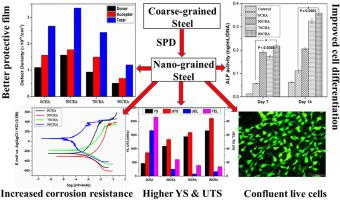当前位置:
X-MOL 学术
›
Mater. Chem. Phys.
›
论文详情
Our official English website, www.x-mol.net, welcomes your feedback! (Note: you will need to create a separate account there.)
Unraveling the effects of nano-grained microstructure on mechanical behavior, corrosion, and in vitro biocompatibility of 316L austenitic stainless steel
Materials Chemistry and Physics ( IF 4.6 ) Pub Date : 2024-04-03 , DOI: 10.1016/j.matchemphys.2024.129292 N. Surya Prakash , Santanu Mandal , Debalay Chakrabarti , Mangal Roy
Materials Chemistry and Physics ( IF 4.6 ) Pub Date : 2024-04-03 , DOI: 10.1016/j.matchemphys.2024.129292 N. Surya Prakash , Santanu Mandal , Debalay Chakrabarti , Mangal Roy

|
Nanograins are often beneficial in achieving better cytocompatibility for metallic implants. In this work, we have achieved grains from the micro to nano range in 316L austenitic stainless steel by a combination of cryo-rolling (50%, 70%, and 90% thickness reduction) followed by annealing (750–1000 °C for 2–20 min). The combined effect of grain refinement along with texture on its mechanical, corrosion, and cellular behavior was thoroughly investigated. Microstructural observations revealed nanograins formation (grain size = 144 nm) only for the 90CRA sample, whereas grain refinement in the micron range was observed for 0-70CRA samples. Electron backscatter diffraction (EBSD) studies showed fully austenitic structures for all the annealed samples while low Kernel Average Misorientation (KAM) values indicated strain-free microstructures. Orientation distribution function (ODF) maps showed the presence of strong γ-fiber (<111>||ND) and weak α-fiber (<110>||ND) in the 90CRA sample. The grain refinement led to an increase in the yield strength and ultimate tensile strength from 470.6 ± 16.21 MPa and 858.35 ± 31.82 MPa (0CRA) to 1662.06 ± 58.44 MPa and 2112.3 ± 51.62 MPa (90CRA), respectively. The potentiodynamic polarization study revealed that the corrosion rate of the 90CRA sample was about eight times less than that of the 0CRA sample. This was further corroborated by Mott-Schottky analysis, which showed a lowering of both acceptor and donor densities with the reduction in grain size. The evolution of a strong <111> texture during cryo-rolling contributed towards enhanced corrosion resistance of nano-grained 316L. Furthermore, grain refinement improved wettability, which in turn led to better cell proliferation and differentiation. At all culture days, MC3T3-E1 cell proliferation and differentiation were considerably higher for nano-grained 316L micron-sized counterparts. Thus, grain refinement to the nano range is an effective technique for the property enhancement of biomedical implants.
中文翻译:

揭示纳米晶微观结构对 316L 奥氏体不锈钢机械行为、腐蚀和体外生物相容性的影响
纳米颗粒通常有利于金属植入物获得更好的细胞相容性。在这项工作中,我们通过结合低温轧制(厚度减少 50%、70% 和 90%)和退火(750–1000 °C,持续 2 次),在 316L 奥氏体不锈钢中实现了从微米到纳米范围的晶粒。 –20 分钟)。彻底研究了晶粒细化和织构对其机械、腐蚀和泡孔行为的综合影响。微观结构观察显示,仅 90CRA 样品形成纳米晶粒(晶粒尺寸 = 144 nm),而 0-70CRA 样品则观察到微米范围内的晶粒细化。电子背散射衍射 (EBSD) 研究显示所有退火样品均具有完全奥氏体结构,而低核平均取向误差 (KAM) 值表明无应变微观结构。取向分布函数 (ODF) 图显示 90CRA 样品中存在强 γ 纤维 (<111>||ND) 和弱 α 纤维 (<110>||ND)。晶粒细化导致屈服强度和极限抗拉强度分别从 470.6 ± 16.21 MPa 和 858.35 ± 31.82 MPa (0CRA) 增加到 1662.06 ± 58.44 MPa 和 2112.3 ± 51.62 MPa (90CRA)。动电位极化研究表明,90CRA 样品的腐蚀速率比 0CRA 样品大约低八倍。莫特-肖特基分析进一步证实了这一点,该分析表明受体和供体密度随着晶粒尺寸的减小而降低。低温轧制过程中强<111>织构的演变有助于增强纳米晶316L的耐腐蚀性。此外,晶粒细化提高了润湿性,从而导致更好的细胞增殖和分化。在所有培养日中,MC3T3-E1 细胞的增殖和分化程度明显高于纳米颗粒 316L 微米尺寸的细胞。因此,晶粒细化至纳米范围是增强生物医学植入物性能的有效技术。
更新日期:2024-04-03
中文翻译:

揭示纳米晶微观结构对 316L 奥氏体不锈钢机械行为、腐蚀和体外生物相容性的影响
纳米颗粒通常有利于金属植入物获得更好的细胞相容性。在这项工作中,我们通过结合低温轧制(厚度减少 50%、70% 和 90%)和退火(750–1000 °C,持续 2 次),在 316L 奥氏体不锈钢中实现了从微米到纳米范围的晶粒。 –20 分钟)。彻底研究了晶粒细化和织构对其机械、腐蚀和泡孔行为的综合影响。微观结构观察显示,仅 90CRA 样品形成纳米晶粒(晶粒尺寸 = 144 nm),而 0-70CRA 样品则观察到微米范围内的晶粒细化。电子背散射衍射 (EBSD) 研究显示所有退火样品均具有完全奥氏体结构,而低核平均取向误差 (KAM) 值表明无应变微观结构。取向分布函数 (ODF) 图显示 90CRA 样品中存在强 γ 纤维 (<111>||ND) 和弱 α 纤维 (<110>||ND)。晶粒细化导致屈服强度和极限抗拉强度分别从 470.6 ± 16.21 MPa 和 858.35 ± 31.82 MPa (0CRA) 增加到 1662.06 ± 58.44 MPa 和 2112.3 ± 51.62 MPa (90CRA)。动电位极化研究表明,90CRA 样品的腐蚀速率比 0CRA 样品大约低八倍。莫特-肖特基分析进一步证实了这一点,该分析表明受体和供体密度随着晶粒尺寸的减小而降低。低温轧制过程中强<111>织构的演变有助于增强纳米晶316L的耐腐蚀性。此外,晶粒细化提高了润湿性,从而导致更好的细胞增殖和分化。在所有培养日中,MC3T3-E1 细胞的增殖和分化程度明显高于纳米颗粒 316L 微米尺寸的细胞。因此,晶粒细化至纳米范围是增强生物医学植入物性能的有效技术。



























 京公网安备 11010802027423号
京公网安备 11010802027423号